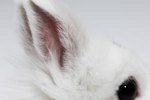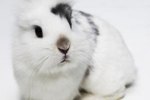
Rabbits graze on grass and leafy weeds that contain lots of hard-to-digest cellulose. To cope with a diet that is hard to extract nutrients from, rabbits have developed a unique digestive system. A lot of their digestion takes place in the cecum, and rabbits produce two different types of droppings. Those that have lots of vitamins pass through the digestive system a second time to extract maximum nutrition.
Mouth to Small Intestine
A rabbit grinds his food thoroughly before he swallows it. The ground-up plant material travels down the esophagus to the stomach, where acid and enzymes start to break it down. From the stomach it moves to the small intestine, where a lot of the protein, sugar and starch absorbs into the bloodstream. Up to this point, the process is the same as for most mammals. After this point, things are different.
Meet the Cecum
The cecum is a chamber between the large and small intestines. The cecum of a rabbit is about 10 times larger than the stomach and contains protozoa, bacteria and yeast that ferment the food that passes inside. Large fragments of indigestible fiber go straight to the large intestine, while smaller particles of digestible fiber move into the cecum to begin the fermentation process. The cecum absorbs some of the nutrients released, but not all.
Two Types of Droppings
The indigestible fiber is expelled as droppings that are like squashed spheres and are dry and friable. The cecum produces cecotropes, which are full of nutrients. After several hours, this material is forced back into the colon, where it gets coated with mucus before passing through the anus. It looks like a tight bunch of small brown grapes. These soft droppings are full of vitamins and nutrients.
Poop Recycling
The rabbit will consume the cecotrope as soon as he expels it. This allows it to travel through the entire digestive system again so the rabbit can obtain additional nutrients. This process might sound disgusting, but cecotropes are not feces; if the rabbit did not eat them, he would become malnourished and eventually die. They are full of nutrients and essential to the health of the rabbit.
References
Resources
Photo Credits
-
Digital Vision/Photodisc/Getty Images




